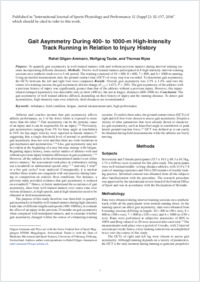Gait asymmetry during 400- to 1000-m high-intensity track running in relation to injury history
- Gilgen-Ammann, Rahel Swiss Federal Inst of Sport Magglingen SFISM, Magglingen, Switzerland
- Taube, Wolfgang Movement and Sport Sciences, Department of Medicine, University of Fribourg, Switzerland
- Wyss, Thomas Swiss Federal Inst of Sport Magglingen SFISM, Magglingen, Switzerland
-
05.12.2016
Published in:
- International Journal of Sports Physiology and Performance. - 2016, vol. 12, no. Suppl 2, p. S2-157
English
Purpose: To quantify gait asymmetry in well-trained runners with and without previous injuries during interval training sessions incorporating different distances.Methods: Twelve well-trained runners participated in 8 high-intensity interval-training sessions on a synthetic track over a 4-wk period. The training consisted of 10 × 400, 8 × 600, 7 × 800, and 6 × 1000-m running. Using an inertial measurement unit, the ground- contact time (GCT) of every step was recorded. To determine gait asymmetry, the GCTs between the left and right foot were compared.Results: Overall, gait asymmetry was 3.3% ± 1.4%, and over the course of a training session, the gait asymmetry did not change (F1,33 = 1.673, P = .205). The gait asymmetry of the athletes with a previous history of injury was significantly greater than that of the athletes without a previous injury. However, this injury-related enlarged asymmetry was detectable only at short (400 m), but not at longer, distances (600–1000 m).Conclusion: The gait asymmetry of well-trained athletes differed, depending on their history of injury and the running distance. To detect gait asymmetries, high-intensity runs over relatively short distances are recommended.
- Faculty
- Faculté des sciences et de médecine
- Department
- Département de Médecine
- Language
-
- English
- Classification
- Sports sciences
- License
- License undefined
- Identifiers
-
- RERO DOC 306761
- DOI 10.1123/ijspp.2016-0379
- Persistent URL
- https://folia.unifr.ch/unifr/documents/306382
Statistics
Document views: 71
File downloads:
- tau_gad.pdf: 138
